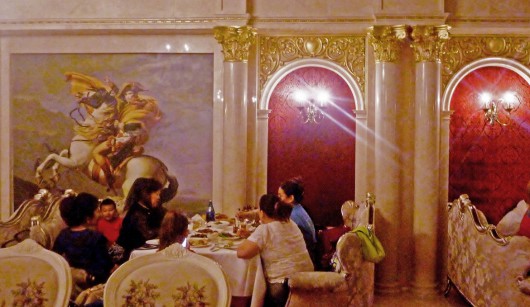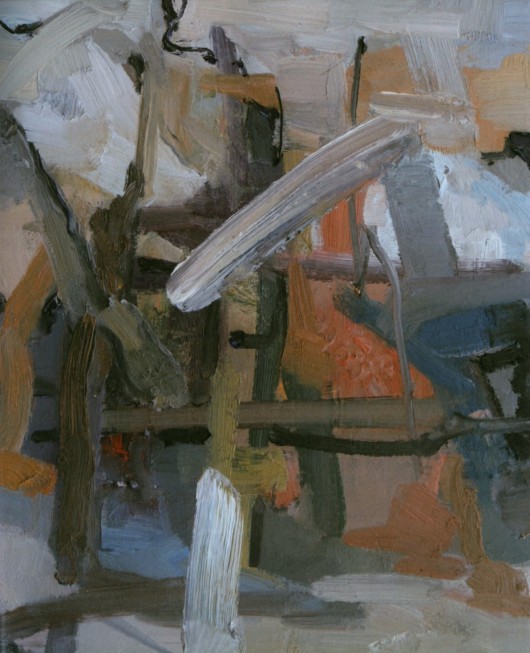
On the top floor of the Aq Saray, or White Palace, hotel in Ürümchi is a massive reproduction of Napoleon Crossing the Alps by Jacques-Louis David. It is flanked on its left by a reproduction of Ivan Kramskoi’s Portrait of an Unknown Woman (which everyone associates with Anna Karenina). Across the expansive red room, otherwise decorated in the style of a Russian tea room, gigantic reproductions of Venetian canals and cityscapes fill out the walls. Overhead murals of clouds, star constellations, and pheasants in flight glow against the ornate heavy white archways that surround them.
The paintings are the works of Dilmurat Abdukadir – who was hired by the owner of the restaurant to produce life-sized images of paintings the owner had found on the Internet. The space is fascinating. Not only does it unapologetically embrace an amalgam of European aesthetics, but it is symptomatic of larger trends in Uyghur restaurant politics and aesthetics.
Somewhere around 2008, scholars began to notice that Turkish imports were on the rise in Xinjiang. Suddenly chocolates from the massive Turkish food conglomerate Ülker could be found everywhere; Turkish coffee products from Mahmood began to replace Nescafe. Advertisements for Turkish products endorsed by celebrity Uyghurs like Abdulla began to saturate Uyghur-language television. Non-Chinese products were suddenly the products of choice for middle-class consumers.
In the years since, the Uyghur food industry has changed in significant ways. As Uyghurs lost more and more control over the architecture of built environment, the interior spaces of restaurants became a space of potential. Inspired by what they had seen on trips to Turkey and Europe, the new class of food importers and restaurateurs began to transform the more traditional opulence of Uyghur banquet halls into spaces whose aesthetic was borrowed at least in part from someplace else.
As social scientists since Pierre Bourdieu have noted, people with disposable incomes purchase forms of distinction by cultivating a sense of taste in what they consume. Middle-class Uyghurs perform their distinctiveness as high-class Uyghurs by eating Uyghur-style Turkish food in uniquely non-Chinese spaces. They go to these restaurants to be seen by other Uyghurs. In an iteration of capitalist development around the world, new upscale restaurants are becoming sites of “conspicuous consumption.”
The expansion of Uyghur interior design to include Turkish and Western elements has translated into a substantial source of income for Uyghur painters such as Dilmurat. Although painting for hire sometimes grates against their passion to follow their own artistic impulses, since the market for their own work is quite small, it is often a primary way through which they are able to supplement their incomes. Most painters who pay their bills doing commercial art for Uyghur businessmen are formally trained. They have studied art history and can talk to you for hours about the purity of art and how it is an expression of their deepest feelings. As Dilmurat put it:
“(Normally) painting is one of the only things I enjoy in life. But when I paint on commission, like with my pieces at Aq Saray, it is just the opposite. It is absolutely depressing. I hate it. I’m copying other people’s work. It feels terrible to me, but I need the money. And having money is also something I enjoy a bit.”
Although new restaurants sometimes pay him to fill out their European or Turkish aesthetic, the same can’t be said yet about private art buyers. He said:
“Uyghurs really haven’t developed much appreciation or understanding of art so I really can’t rely on (art sales). One person who bought my work told me that he just bought it because the frame was nice. He tore out the art work and just used the frame for something else. This kind of attitude is really common.”
Part of the problem here is that given his druthers Dilmurat paints in an abstract expressionist style. When some Uyghurs look at his painting they don’t see anything other than squiggles and lines.
He said: “I came to like abstract forms of art through food. Seeing the way certain foods were displayed in different color formations is what first made me think about painting in blocks of color. I like the feeling and sense of it. I can feel a certain form of rightness as I work with the color and paint.”
He said that, over the arc of his career as an artist, the way he was able to pour his feeling into a painting became an important therapeutic practice for him.
“When I paint I lose all track of time. Ten or 15 hours can pass and I won’t even notice. I don’t stop to eat or anything. I just get lost in time. When I come out of it, I have some results, but I also feel as if that time has just vanished. I have no memory of it. You could say that I am wasting my life, but for me painting is the only thing that keeps me sane. If I couldn’t paint I would probably have a serious mental illness. Painting is one of the only things I enjoy in life.”
As one of the leaders in the Uyghur contemporary art scene, Dilmurat’s passion for art as a-way-of-life seems unmatched. He reads Nietzsche and talks about how true art is the “real expression of the artist” and that the most important thing is that “the artist gets some enjoyment out of it, that it feels good for him.” Despite their marginalization, Dilmurat and his group of contemporary artists still keep painting – if not for recognition, then for themselves. That practice and the friendships that emerge out of it are one of the things that give their lives meaning.
Despite the way Dilmurat likes to distance himself from his work as an interior decorator, if you bring him down to the White Palace you will see that he is also a bit proud to see the atmosphere his work creates. When Uyghur diners walk into the room they are often impressed to see that a Uyghur artist can replicate masterworks of European art with so much precision. For many, entering the room for the first time is transportive. The waiters wear white gloves. A flamenco band sings in Spanish under a galloping Napoleon. The glow of the soft lights. The taste of honey in the mint tea. All of it feels refined.
Beige Wind runs the website The Art of Life in Chinese Central Asia, which attempts to recognize and create dialogue around the ways minority people create a durable existence, and, in turn, how these voices from the margins implicate all of us in simultaneously distinctive and connected ways.


















































A bit OT here Anthony, but given the paucity of comments….
You can bet (a Maersk container load of Frisbees and disgruntled expats with book publishing contracts) that there is no absolutely mention in Chinese media of Japans (The Blossoms, and forget the gay jokes) stunning rugby union victory over South Africa this morning, so soon after The Diet passed legislation allowing its armed forces to participate in situations beyond its territorial boundaries.
My advice is that the PLA has moved to DEFCOM 4 and the Politburo, its mistresses and hangers-on have all relocated to a nuclear shelter.